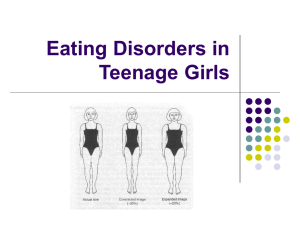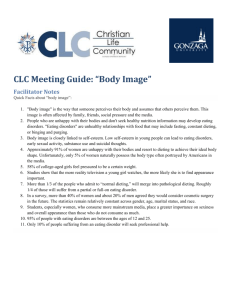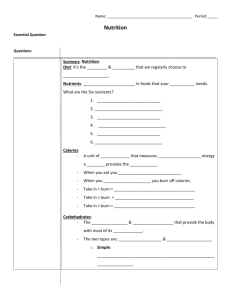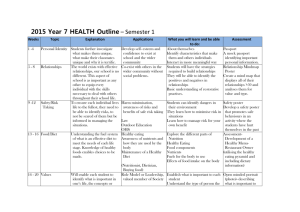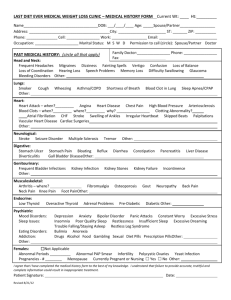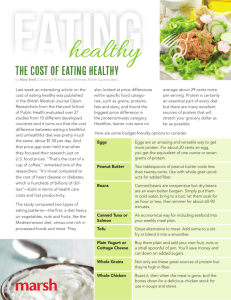Psychological Determinants of Dieting among Teenage Girls 15-18 Years
advertisement
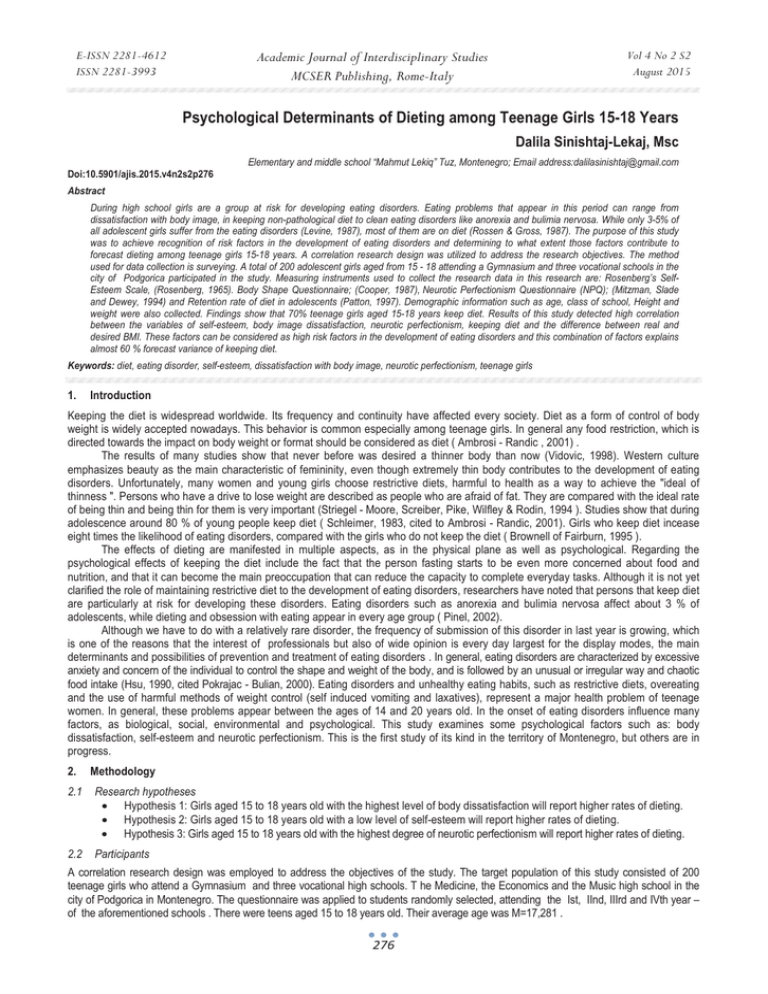
Academic Journal of Interdisciplinary Studies MCSER Publishing, Rome-Italy E-ISSN 2281-4612 ISSN 2281-3993 Vol 4 No 2 S2 August 2015 Psychological Determinants of Dieting among Teenage Girls 15-18 Years Dalila Sinishtaj-Lekaj, Msc Doi:10.5901/ajis.2015.v4n2s2p276 Elementary and middle school “Mahmut Lekiq” Tuz, Montenegro; Email address:dalilasinishtaj@gmail.com Abstract During high school girls are a group at risk for developing eating disorders. Eating problems that appear in this period can range from dissatisfaction with body image, in keeping non-pathological diet to clean eating disorders like anorexia and bulimia nervosa. While only 3-5% of all adolescent girls suffer from the eating disorders (Levine, 1987), most of them are on diet (Rossen & Gross, 1987). The purpose of this study was to achieve recognition of risk factors in the development of eating disorders and determining to what extent those factors contribute to forecast dieting among teenage girls 15-18 years. A correlation research design was utilized to address the research objectives. The method used for data collection is surveying. A total of 200 adolescent girls aged from 15 - 18 attending a Gymnasium and three vocational schools in the city of Podgorica participated in the study. Measuring instruments used to collect the research data in this research are: Rosenberg’s SelfEsteem Scale, (Rosenberg, 1965). Body Shape Questionnaire; (Cooper, 1987), Neurotic Perfectionism Questionnaire (NPQ); (Mitzman, Slade and Dewey, 1994) and Retention rate of diet in adolescents (Patton, 1997). Demographic information such as age, class of school, Height and weight were also collected. Findings show that 70% teenage girls aged 15-18 years keep diet. Results of this study detected high correlation between the variables of self-esteem, body image dissatisfaction, neurotic perfectionism, keeping diet and the difference between real and desired BMI. These factors can be considered as high risk factors in the development of eating disorders and this combination of factors explains almost 60 % forecast variance of keeping diet. Keywords: diet, eating disorder, self-esteem, dissatisfaction with body image, neurotic perfectionism, teenage girls 1. Introduction Keeping the diet is widespread worldwide. Its frequency and continuity have affected every society. Diet as a form of control of body weight is widely accepted nowadays. This behavior is common especially among teenage girls. In general any food restriction, which is directed towards the impact on body weight or format should be considered as diet ( Ambrosi - Randic , 2001) . The results of many studies show that never before was desired a thinner body than now (Vidovic, 1998). Western culture emphasizes beauty as the main characteristic of femininity, even though extremely thin body contributes to the development of eating disorders. Unfortunately, many women and young girls choose restrictive diets, harmful to health as a way to achieve the "ideal of thinness ". Persons who have a drive to lose weight are described as people who are afraid of fat. They are compared with the ideal rate of being thin and being thin for them is very important (Striegel - Moore, Screiber, Pike, Wilfley & Rodin, 1994 ). Studies show that during adolescence around 80 % of young people keep diet ( Schleimer, 1983, cited to Ambrosi - Randic, 2001). Girls who keep diet incease eight times the likelihood of eating disorders, compared with the girls who do not keep the diet ( Brownell of Fairburn, 1995 ). The effects of dieting are manifested in multiple aspects, as in the physical plane as well as psychological. Regarding the psychological effects of keeping the diet include the fact that the person fasting starts to be even more concerned about food and nutrition, and that it can become the main preoccupation that can reduce the capacity to complete everyday tasks. Although it is not yet clarified the role of maintaining restrictive diet to the development of eating disorders, researchers have noted that persons that keep diet are particularly at risk for developing these disorders. Eating disorders such as anorexia and bulimia nervosa affect about 3 % of adolescents, while dieting and obsession with eating appear in every age group ( Pinel, 2002). Although we have to do with a relatively rare disorder, the frequency of submission of this disorder in last year is growing, which is one of the reasons that the interest of professionals but also of wide opinion is every day largest for the display modes, the main determinants and possibilities of prevention and treatment of eating disorders . In general, eating disorders are characterized by excessive anxiety and concern of the individual to control the shape and weight of the body, and is followed by an unusual or irregular way and chaotic food intake (Hsu, 1990, cited Pokrajac - Bulian, 2000). Eating disorders and unhealthy eating habits, such as restrictive diets, overeating and the use of harmful methods of weight control (self induced vomiting and laxatives), represent a major health problem of teenage women. In general, these problems appear between the ages of 14 and 20 years old. In the onset of eating disorders influence many factors, as biological, social, environmental and psychological. This study examines some psychological factors such as: body dissatisfaction, self-esteem and neurotic perfectionism. This is the first study of its kind in the territory of Montenegro, but others are in progress. 2. Methodology 2.1 Research hypotheses • Hypothesis 1: Girls aged 15 to 18 years old with the highest level of body dissatisfaction will report higher rates of dieting. • Hypothesis 2: Girls aged 15 to 18 years old with a low level of self-esteem will report higher rates of dieting. • Hypothesis 3: Girls aged 15 to 18 years old with the highest degree of neurotic perfectionism will report higher rates of dieting. 2.2 Participants A correlation research design was employed to address the objectives of the study. The target population of this study consisted of 200 teenage girls who attend a Gymnasium and three vocational high schools. T he Medicine, the Economics and the Music high school in the city of Podgorica in Montenegro. The questionnaire was applied to students randomly selected, attending the Ist, IInd, IIIrd and IVth year – of the aforementioned schools . There were teens aged 15 to 18 years old. Their average age was M=17,281 . 276 Academic Journal of Interdisciplinary Studies MCSER Publishing, Rome-Italy E-ISSN 2281-4612 ISSN 2281-3993 Vol 4 No 2 S2 August 2015 2.3 Instrumentation Four research instruments were utilized to collect the research data. The instrument used to assess teenagers self-esteem was the Rosenberg’s Self-Esteem Scale, 1965. This scale is 10-item scale that measures global self-worth by measuring both positive and negative feelings about the self. All items are answered using a 4-point Liker scale format ranging from strongly agree to strongly disagree. The adolescent’s body dissatisfaction was measured using the Body Shape Questionnarie, developed by Cooper, Taylor, Cooper, Fairburn in 1987. The questionnaire measures the satisfaction/dissatisfaction with the body. It consists of 34 itemized. The respondents expressed concern about the appearance of the body at the rate of 6 degrees type Linker (never, rarely, sometimes, often, very often, always during the last four weeks). The total score is determined by calculating the estimates and ranges from 34 to 204. To measure the perfectionism among adolescent girls the Neurotic Perfectionism Questionnaire developed in 1994, by Mitzman, Slade & Devey were used. NPQ is a self reporting scale which was built to measure perfectionism to people with eating disorders. It showed very good gauge for differentiation of perfectionism, non-perfectionism and normal/neurotic perfectionism. The original scale consists of 42 item ( voices ), and answers are scored at a rate of 5 degrees : 1- I am not at all agree , to 5 - I totally agree . Results may vary from 42 to 210 points, with the biggest score indicates a higher level perfection. To measure the extent of dieting is used customized version of the Adolescent Dieting Scale, (Patton and co., 1997). This scale consists of 8 itemized and includes three typical strategy of maintaining diet (counting calories, reducing the amount of food as well as overcoming the meal). Respondents may apply to each question with one of the four answers given, ranging from 0 (rarely or never) to 3 (almost always). Total score scale of points gained by the collection, where higher score indicates the presence of extreme form of diet. Scale scores can range from 0 to 24. Body Mass Index – BMI is a scale that determines whether you have an appropriate weight for your height. In this study we used real and desired index of body mass and the difference between them. 3. Findings and discussion Table 1. Descriptive data of the sample of the adolescent girls ( N = 200 ) in the Rosenberg self-esteem scale, on body dissatisfaction questionnaire, on neurotic perfectionism questionnaire, on the scale of diet keeping, on real and desired BMI as well as on the difference between BMI 's Variable Number Mean Standart deviation Distribution Theoretical distribution Self-esteem 200 24.7912 4.57719 9.00-30.00 0 – 30 Body dissatisfaction 200 67.0284 28.15212 34.00 - 175.00 34 - 204 Neurotic perfectionsm 200 72.7076 24.18621 35.00 -156.00 35 - 175 Diet 200 7.51 7.779 0-24 0-24 Real BMI 200 23.9503 3.11954 17.21- 40.77 10-50 Desired BMI 200 22.9241 2.27382 16.64- 33.32 The difference between real and desired BMI 200 - 1.0448 2.17726 -11.04-6.00 Table 2. Distribution and percentage of dieting Frequency 53 140 193 7 200 Valid Dont keep diet Keep diet Total Missing System Total Valid percent 27.5 72.5 100.0 Table 3. Distribution and percentage of self-esteem Frequency 5 22 155 182 18 200 Valid Low self - esteem Moderate self - esteem High self - esteem Total Missing System Total Valid percent 2.7 12.1 85.2 100.0 Table 4. Distribution and percentage of body dissatisfaction Valid Missing Total Low body dissatisfaction Moderate body dissatisfaction High body dissatisfaction Total System Frequency 89 73 14 176 24 200 Valid percent 53.4 43.8 8.4 100.0 Frequency 134 26 11 171 29 200 Valid percent 78.4 15.2 6.4 100.0 Table 5. Distribution and percentage of neurotic perfectionsm Valid Low neurotic perfectionsm Moderate neurotic perfectionsm High neurotic perfectionsm Total Missing System Total 277 Academic Journal of Interdisciplinary Studies MCSER Publishing, Rome-Italy E-ISSN 2281-4612 ISSN 2281-3993 Vol 4 No 2 S2 August 2015 Table 6. Distribution and percentage of real BMI Frequency 10 138 51 199 1 200 Valid Underweight Average weight Overweight Total Missing System Total Valid percent 5.0 69.0 25.5 100.0 Tabela 7. Distribution and percentage of desired BMI Frequency 13 160 22 195 5 200 Valid Desired underweight Desired average weight Desired overweight Total Missing System Total Valid percent 6.5 80.0 11.0 100.0 Table 8. Distribution and percentage of the difference between real BMI and desired BMI Frequency 122 41 29 178 5 200 Valid Wish to be thinner Satisfied with the weight Wish to be fatter Total Missing System Total Valid percent 63.5 21.0 15.5 100.0 The abovementioned table shows that 122 (63.5 %) of our sample girls want to be thinner, 41 (21 %) girls are happy with the weight they have, and 29 or 15.5 % of girls want to be fatter of that. Based on the analysis of multiple correlation between maintaining diet (dependent variable) and independent variables is seen a correlation of high level. Table 9. Gives details of the correlation between all variables As noted in Table 9, the correlation of higher level exists between diet and body dissatisfaction (r = 0.707). Correlation between diet and the difference between real and desired BMI is also high r = 0.549. Neurotic perfectionism is also associated with maintaining the diet at a level of r = 0.386. And the correlation coefficient r = - 0.147 shows that there is a low negative correlation but statistically significant between self-esteem and dieting. Based on " Model Summary " it can be said that self-esteem, body dissatisfaction, neurotic perfectionism and the difference between real and desired BMI are strongly associated with dieting in a correlation of R = 0771. On the basis of the value of the R square (0.594), we can say that 59.4 % can forecast dieting of from independent variables. The adjusted R-square value of 0.578, shows that the model is successful because it has accounted for 58 % of the variance of the dependent variable. Table 10. Data on regression, values which indicate the contribution of each independent variable on the dependent variable As noted in Table 10, body dissatisfaction is the most predictive factor for maintaining diet where ȕ = 0.584, t = 7.378 and p < 0.000. Another factor affecting the dependent variable is the difference between real and desired BMI with the regression coefficient ȕ = 0.314, t = 4,765 and p < 0.000. Variables of self-esteem and neurotic perfectionism do not contribute statistically and do not explain the variance of our variable dependent, so that their contribution to this set of variables is statistically insignificant. 4. Discussion and Conclusion The purpose of this study was to achieve recognition of risk factors in the development of eating disorders and determining to what extent those factors contribute to forecast maintaining diet among teenage girls 15-18 years. In this study included 200 subjects 15-18 years of age. The average age of subjects was 17.281, while the standard deviation is 0. 9698. Subjects follow three vocational high schools and a gymnasium in the city of Podgorica. From this study has emerged that adolescent girls 15-18 years maintain diet on a large extent. From the 200 girls that participated in the study, 140 maintain diet, which means that more than 70 % maintain different diets. Results of this study also show that maintaining diet among teenage girls 15-18 years is closely related to body dissatisfaction, neurotic perfectionism, self-esteem and BMI in the subjects. From the table of correlation it has emerged that the highest positive correlation is between body dissatisfaction and 278 E-ISSN 2281-4612 ISSN 2281-3993 Academic Journal of Interdisciplinary Studies MCSER Publishing, Rome-Italy Vol 4 No 2 S2 August 2015 dieting (r = 0.707; p<0.01) which indicate that girls are more dissatisfied with the appearance of the body maintain more diet with what is proved the first hypothesis of our study. In literature is a clear evidence upon which the negative perception of body image forecast seriousness of eating disorders and in maintaining the diet, and those in greater extent than other psychological variables. It is also known that body dissatisfaction and weight loss attempts are common among teenage girls in Western culture; more than 50% of adolescent girls report that maintain diet, but even greater is the percentage of those who want to be thinner (Huon,1994; Wertheim, Paxton, Maude, Szmukler, Gibbons of Hiller, 1992, cited Ambrosi - Randic, 2001). The authors often emphasize dissatisfaction with body image as a variable associated with the frequency of dieting ( Polivy and Heatherton, 1992; Miller, 1980, cited Pokrajac - Bulian, 2000). Also, (Miller and associates, 1980) in their study found that 81% of persons dissatisfied with the appearance of the body maintain diet. The correlation coefficient r = -0,147; (P<0.01) shows that there is a low negative correlation but variable statistically significant between the self-esteem and dieting. This shows that girls with low self-esteem achieve higher scores on a scale of dieting, which support the second hypothesis of our study. This means that low self-esteem is also associated with irregular habits and attitudes of nutrition in some clinical groups of students (Mayhew and Edelmann, 1989). It is important to note that the general feeling of self-esteem is closely linked with the body satisfaction and self-esteem for the body. Women with eating disorders have very low self-esteem, hold themselves for bad people and fear of rejection and abandonment (Johnson Connors, 1987, cited Pokrajac -Bulian, 2000). The correlation coefficient of the variables neurotic perfectionism and diet is r = 0.386 ( p<0.01). So between these two variables mentioned there is a relatively low correlation, but statistically significant positive which also is expected, according to data from the literature on the variable of perfectionism as risky factor in the development of eating disorders. Girls who show higher scores on neurotic perfectionism questionnaire have more points at the scale of dieting among adolescents, which verified the third hypothesis of our study. Achieved results can indicate that teenage girls aged 15-18 years maintain diet pretty much. There were detected high correlation between the variables of self-esteem, body dissatisfaction, neurotic perfectionism, the difference between real and desired BMI and dieting. These factors can be considered as high risk factors in the development of eating disorders and this combination of factors explains almost 60 % forecast variance of dieting. Identifying these factors and other factors that should be explored also will help in the design of prevention programs of this phenomenon. Reference American Psychiatric Association. (2000). Diagnostic and statistical manual of mental disorders (4th ed-TR). Washington, DC: Author Ambrosi – Randic, N. (2001). Biološki, psihološki i socijalni faktori u razvoju poremecaja hranjenja. Doktorska disertacija. Zagreb: Filozofski fakultet. Ambrosi – Randic, N. (2004). Razvoj poremecaja hranjenja. Jastrebrovo: Naklada Sklap. Ashby, J. S., Kottman, T., et al. (1998). Perfectionism and eating disorders reconsidered.Journal of Mental Health Counseling, Vol. 20 Issue 3, p261, 11p. Brownell, K. D.& Fairburn, C. G. (1995). Eating disorders and obesity: A comprehensive handbook. New York: The Guilford Press. Coopersmith, S. (1967). The Antecedents of Self-esteem. San Francisco: W. H. Freeman and Company. Davison, G. C. i Neale, J. M. (1999). Psihologija abnormalnog doživljavanja i ponašanja. Jastrebarsko: Naklada Slap. Edlund, B., Halvarsson, K., Gebre-Mehdin, M. & Sjödén, P-O. (1999).Psychological correlates of dieting in Swedish adolescents: A cross-sectional study. European Eating Disorders Review, 7, 47-61 Fairburn, C. G. (1997). Eating Disorders. In C. G. Fairburn and D. M. Clark (Eds.). Science and practice of Cognitive Behaviour Therapy (pp. 209 – 241). Oxford: Oxford University Press. Fleming, J. S. & Courtney, B. E. (1984). The dimensionality of self-esteem: II. Hierarchical facet model for revised measurement scales. Journal of Personality and Social Psychology, 46, 404 – 421. Frost, R. O., Marten, P., Lahart, C. and Rosenblate, R. (1990). The Dimensions of Perfectionism. Cognitive Therapy and Research, Vol.14, No.5, pp. 449 – 468. Gustafson-Larson, A.M & Terry, R.D. (1992). Weight-related behaviors and concerns of fourth-grade children. Journal of the American Dietetic Association, 92, 818-822 Herrin, M.,& Matsumoto, N. (2007). The parent’s guide to eating disorders. Carlbad-California: Gurze Books. Hewitt, P. L., Flett, G. L. and Ediger, E. (1995). Perfectionism Traits and Perfectionistic Self-Presentation in Eating Disorder Attitudes, Characteristics, and Symptoms. International Journal of Eating Disorders, Vol.18, No.4, 317-326. Kalonder, C. R. ( 2005). Too fat or too thin? A reference guide to eating disorders. Norwalk: Crown House Publishing Limited. Kostanjcar, D. (2002). Odnos svjesnosti i internalizacije sociokulturalnih stavova o tjelesnom izgledu, maskulinosti, femininosti i zadovoljstva tjelesnim izgledom. Magistarski rad. Zagreb: Filozofski fakukultet. Lackovic– Grgin, K. (1994). Samopoimanje mladih. Jastrebarsko: Naklada Slap. Lask, B. ( 2000). Eating disorders in childhood and adolescence. Current pediatrics, 10, 254-258 Lask, B.,& Bryant – Waught, R. ( 1997). Prepubertal eating disorders. In D. M. Garner&P.E. Garfikinkel ( Eds.), Handbook of treatment for eating disorders: ( 2nd ed.,pp. 476-483). New York: Guilford Press. Lawrence, B.K. ( 1999). Bitter ice. New York: Warner. Levine, M. (1987). Student eating disorders. Washington D.C.: National Education Association of the United States. Pango, Y.( 2004). Psikoterapi. Tiranë: Shtëpia Botuese e Librit Universitar. Patton, G.C., Selzer, R., Coffey, C., Carlin, J.B., & Wolfe, R. (1999). Onset of adolescent eating disorders: population based cohort study over 3 years. British Medical Journal, 318, 765-768. Pinel, J. P. J. (2002). Biološka psihologija. Jastrebarsko: Naklada Slap. Pokrajac – Bulian, A. (2000). Nezadovoljstvo vlastitim tijelom i teškoce emocionalne prilagodbe kao odrednice nastanka poremecaja hranjenja. Doktorska disertacija. Zagreb: Filozoski fakultet. Pokrajac – Bulian, A., Kandare, A.(1999 –2000). Povezanost opseg nezadovoljstva tjelesnim izgledom i nekih aspekata samopoimanja u studentskoj populaciji. Psihologijske teme, No 8-9, 63-77. Rosen, J. C-, & Gross, J. (1987). Prevalence of weight reducing and weight gaining in adolescent girls and boys. Health Psychology, 6, 131-147. Rosenberg, M. (1965). Society and the adolescent self-image. Princeton, NJ: Princeton University Press. Rumney, A. (2007). Dying to please: anorexia, treatment and recovery. ( 2nd ed.,pp. 16-28). Jefferson: McFarland & Company, Inc., Publishers. Vidoviü, V. (1994). Doživljaj tijela u anoreksiji i bulimiji. Zagreb: Medicinska naklada. Vidoviü, V. (1998). Anoreksija i bulimija: psihodinamski pogled na uzroke i posljedice bitke protiv tijela u adolescentica. Zagreb: 4P Biblioteka þasopisa "Psiha". 279
